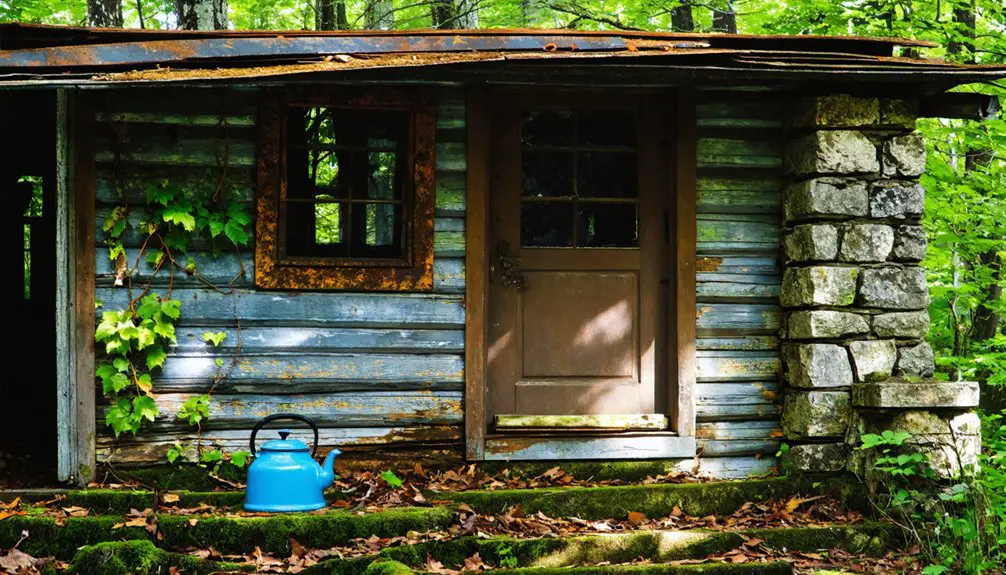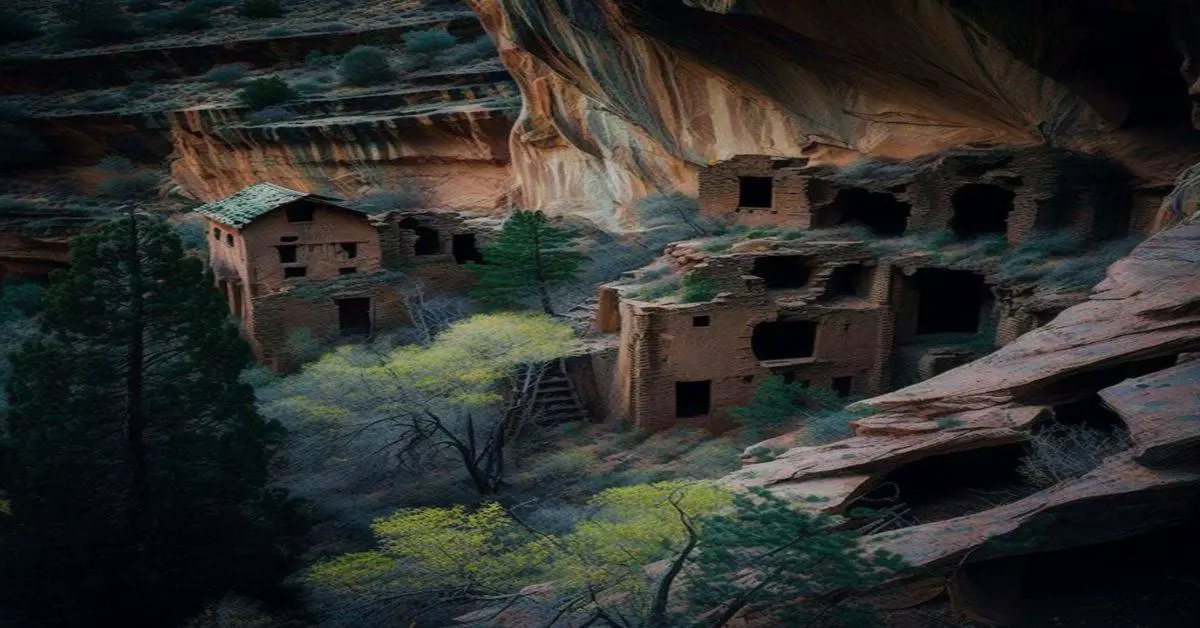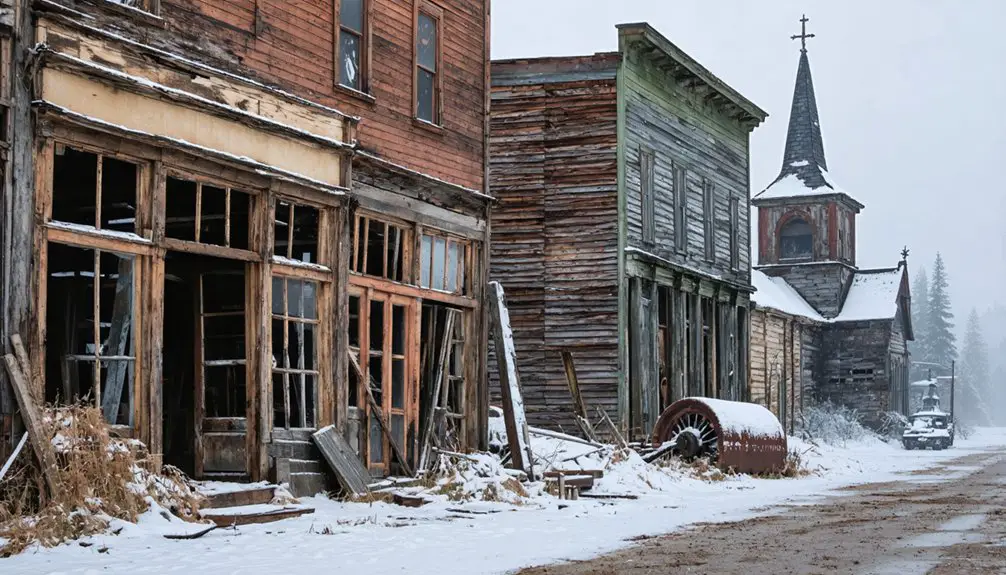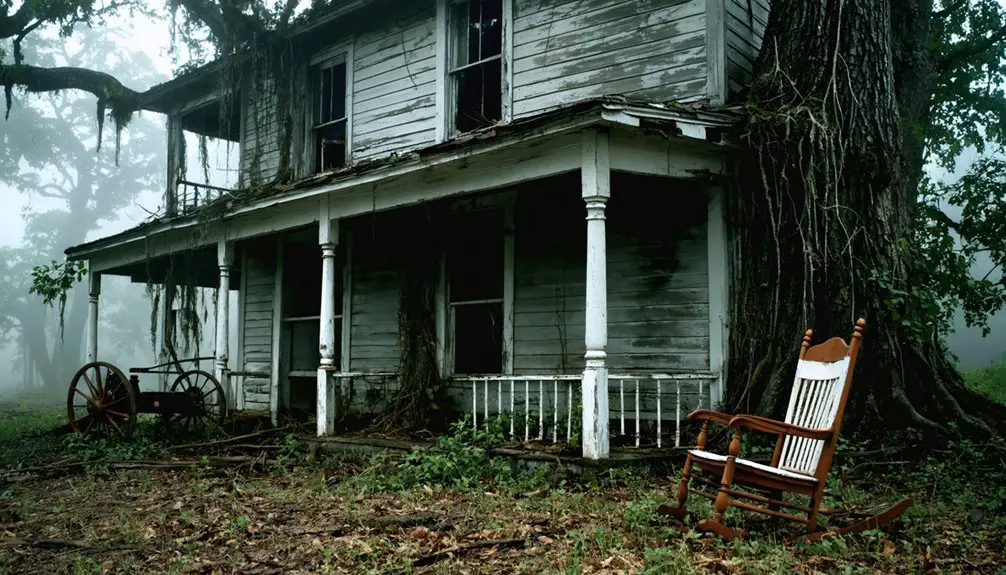You’ll find Freed nestled in West Virginia’s rugged terrain, where decaying buildings and rusted mining equipment tell the story of a once-bustling coal town. The community thrived in the early 1900s as part of the Chesapeake & Ohio Railroad network, with company stores, worker housing, and busy mine portals defining daily life. After a devastating fire in 1922 and declining coal demand, Freed gradually emptied. Today, its weathered remnants offer glimpses into Appalachia’s industrial past.
Key Takeaways
- Freed was a coal company town that declined in the 1920s due to technological changes and reduced demand for steam locomotive coal.
- A devastating fire in 1922 destroyed critical infrastructure, accelerating the town’s abandonment and eventual ghost town status.
- The town’s ruins include weathered buildings, rusted mining equipment, and sealed mine portals scattered across steep terrain.
- Archaeological sites in Freed are protected by the National Park Service as educational resources about industrial history.
- The town’s decline was hastened by its isolation and inability to adapt when coal resources diminished and railroad transport patterns changed.
The Rise of a Coal Mining Community
As coal’s value grew in the late 18th century, West Virginia’s mineral wealth caught the attention of early prospectors and industrialists.
You’ll find that community growth in places like Freed followed a familiar pattern – as railroad lines expanded between 1880-1900, mining companies established company towns near promising coal seams.
The discovery of coal in West Virginia dates back to 1742, but it wasn’t until the Baltimore and Ohio Railroad reached the region that large-scale mining became viable.
West Virginia’s coal remained largely untapped until railroad expansion finally made widespread mining operations economically feasible.
You’d have seen dramatic changes as mining towns sprouted up, bringing waves of workers seeking opportunities.
Yet these communities faced intense labor struggles – miners endured dangerous conditions, were paid in coal scrip, and lived under the economic control of company stores. West Virginia recorded the highest death rates among miners nationwide between 1890 and 1912. The United Mine Workers fought against these conditions, leading to the largest uprising in U.S. labor history at Blair Mountain in 1921.
Their fight for better conditions would eventually spark major labor uprisings across the state.
Life in a Company Town
While coal companies rapidly constructed towns to house their workers, these settlements became far more than just clusters of uniform buildings – they evolved into carefully controlled microcosms of industrial society.
You’d find your place in the town’s rigid social hierarchy reflected in your housing location. If you were a mine administrator, you’d live in a superior house on higher ground. As a white miner, you’d occupy more modest quarters, while Black miners and immigrants would be relegated to the least desirable areas near the mines.
The community dynamics revolved entirely around the company’s control – from the scrip in your pocket that could only be spent at the company store, to the superintendent’s mansion that loomed as a constant reminder of authority. These towns typically lasted 50 to 75 years, depending on how long the coal seams remained productive.
Every aspect of daily life, from shopping to schooling, fell under the company’s watchful eye. Many companies sponsored community events and activities to maintain a sense of order and worker contentment.
Mining Operations and Economic Impact
The explosive growth of West Virginia’s coal industry transformed the state’s economy, with production skyrocketing from 489,000 tons in 1869 to an astounding 89 million tons by 1917.
You’d find mining technology rapidly advancing as railroads penetrated remote mountain areas, enabling massive extraction operations.
As the industry expanded, you’d witness these dramatic changes:
- Your spending power became restricted by coal scrip, forcing you to shop at company-owned stores.
- Your workplace became increasingly dangerous, with mining deaths exceeding WWI combat casualties.
- Your economic freedom diminished as out-of-state corporations seized control of local resources.
- Your labor rights struggles intensified, leading to violent confrontations like the Battle of Blair Mountain.
This corporate dominance reshaped mountain communities, leaving them vulnerable to devastating boom-and-bust cycles that would eventually create ghost towns like Freed.
The Path to Abandonment
Despite its early promise as a bustling railroad hub, Freed’s path to abandonment began in the 1920s when technological shifts and economic pressures converged to undermine the town’s liveliness.
You’ll find that the shift from steam to diesel locomotives dealt the first major blow, as trains no longer needed frequent stops for servicing. This change triggered a cascade of economic vulnerability throughout the community. A devastating fire in 1922 destroyed much of the town’s vital infrastructure. Similar to Salem College, mysterious fires contributed to the decline of several West Virginia communities.
The town’s isolation in the mountainous terrain of West Virginia made it nearly impossible to pivot to new industries.
As coal and timber resources dwindled, population decline accelerated. Young residents moved away seeking opportunities elsewhere, while infrastructure fell into disrepair.
Without investment in roads or modern amenities, Freed’s remaining businesses shuttered one by one, leaving behind empty buildings as silent witnesses to its once-vibrant past.
Physical Remnants and Ghost Town Status
If you visit Freed today, you’ll find weathered structures and mining remnants scattered across the landscape, much like other ghost towns in West Virginia’s New River Gorge region.
The town’s abandoned wooden buildings show typical signs of decay, with collapsed roofs and broken windows slowly being reclaimed by the surrounding forest.
You can still spot rusted mining equipment and sealed mine portals that hint at Freed’s coal-mining past, though many structures have deteriorated considerably over the decades.
Similar to Kaymoor’s mining complex, visitors must navigate steep terrain to explore what remains of Freed’s industrial past.
Many of these former industrial sites now showcase nature’s reclamation, with dense vegetation and wildlife overtaking the once-bustling mining town.
Abandoned Buildings Today
Today, scattered remnants of Freed’s built environment paint a haunting portrait of abandonment across its former township grounds. The architectural nostalgia is evident in weathered facades and boarded windows, while urban decay advances as nature steadily reclaims the land.
You’ll find these striking features throughout the ghost town:
- Residential homes stand frozen in time, their structures weakened by decades of exposure to West Virginia’s harsh elements.
- Former business buildings display faded signage, their empty shells marking where commerce once thrived.
- Vacant schools and churches rest in eerie silence, windows shattered and roofs caving.
- Overgrown streets wind through empty lots where buildings once stood, now transformed by encroaching forest.
Unlike the preserved Thurmond ghost town nearby, Freed’s buildings continue their slow descent into wilderness, largely untouched by preservation efforts. The contrast is stark, as Thurmond benefits from the National Park Service maintaining over 20 of its historic structures. Similar to Thurmond’s decline, the rise of modern highway systems led to the gradual desertion of Freed’s once-bustling streets.
Mining Infrastructure Remains
Silent witnesses to Freed’s industrial past, the mining infrastructure remains stand as rusted monuments throughout the abandoned town.
You’ll find remnants preservation efforts revealing the skeletal framework of coal tipples, deteriorated loading platforms, and weathered rail sidings that once connected to the crucial Chesapeake & Ohio Railroad line. These artifacts of industrial archaeology tell the story of a once-thriving mining operation, with visible foundations of processing buildings and coal chutes emerging from the encroaching vegetation.
Beneath years of natural reclamation, you can still trace the town’s economic lifeline through rusted rails and decaying structural supports.
The scattered spoil heaps and tailings piles mark where miners once extracted the black gold that fueled West Virginia’s industrial growth, before economic shifts led to Freed’s eventual abandonment.
Legacy in West Virginia’s Mining History
Through its dramatic rise and decline, Freed exemplifies the enduring legacy of West Virginia’s coal mining era, joining hundreds of similar ghost towns that once powered America’s industrial revolution.
The town’s story reflects both the cultural heritage of Appalachia’s mining communities and the economic resilience required to survive in company-controlled settlements.
Today, you’ll find these lasting impacts of Freed’s mining history:
- Preserved ruins that serve as outdoor museums, telling stories of tight-knit mining families
- Oral histories passed down through generations, documenting daily life in company towns
- Railroad infrastructure that transformed the region’s transportation landscape
- Archaeological sites protected by the National Park Service, ensuring future generations can explore this essential chapter of American history
Frequently Asked Questions
Are There Any Paranormal Activities or Ghost Stories Associated With Freed?
You won’t find documented ghost sightings or haunted locations here – unlike other regional ghost towns, there aren’t any verified paranormal stories or supernatural legends tied to this abandoned mining community.
Can Visitors Legally Explore the Remains of Freed Today?
While you might want to explore freely, you can’t legally access these ruins without explicit permission. Most structures sit on private property, and you’ll need owner approval following standard exploration guidelines.
What Happened to the Cemetery and Graves of Freed’s Residents?
You’ll find limited cemetery preservation efforts left most grave markers lost to nature, with sites likely relocated due to flooding and environmental threats, similar to other abandoned mining town burial grounds.
Were There Any Major Mining Accidents or Disasters in Freed?
While whispers of ghost sightings echo through old mine shafts, there’s no documented evidence of major mining disasters in Freed, though mining safety concerns were common throughout West Virginia’s coal country.
What Was the Peak Population of Freed During Its Most Prosperous Years?
You won’t find reliable records of Freed’s peak population in mining community history. While similar West Virginia coal towns reached several hundred residents, Freed’s exact numbers remain undocumented through historical archives.
References
- https://www.youtube.com/watch?v=-EeLwLa2t90
- https://www.onlyinyourstate.com/experiences/west-virginia/abandoned-ghost-town-thurmond-wv
- https://www.youtube.com/watch?v=2x_SbnBKfq4
- https://kids.kiddle.co/List_of_ghost_towns_in_West_Virginia
- https://en.wikipedia.org/wiki/List_of_ghost_towns_in_West_Virginia
- https://minesafety.wv.gov/historical-statistical-data/mining-in-west-virginia-a-capsule-history/
- https://www.nps.gov/articles/000/paint-creek-and-cabin-creek-strikes.htm
- https://en.wikipedia.org/wiki/West_Virginia_coal_wars
- https://en.wikipedia.org/wiki/Battle_of_Blair_Mountain
- https://www.smithsonianmag.com/history/battle-blair-mountain-largest-labor-uprising-american-history-180978520/



